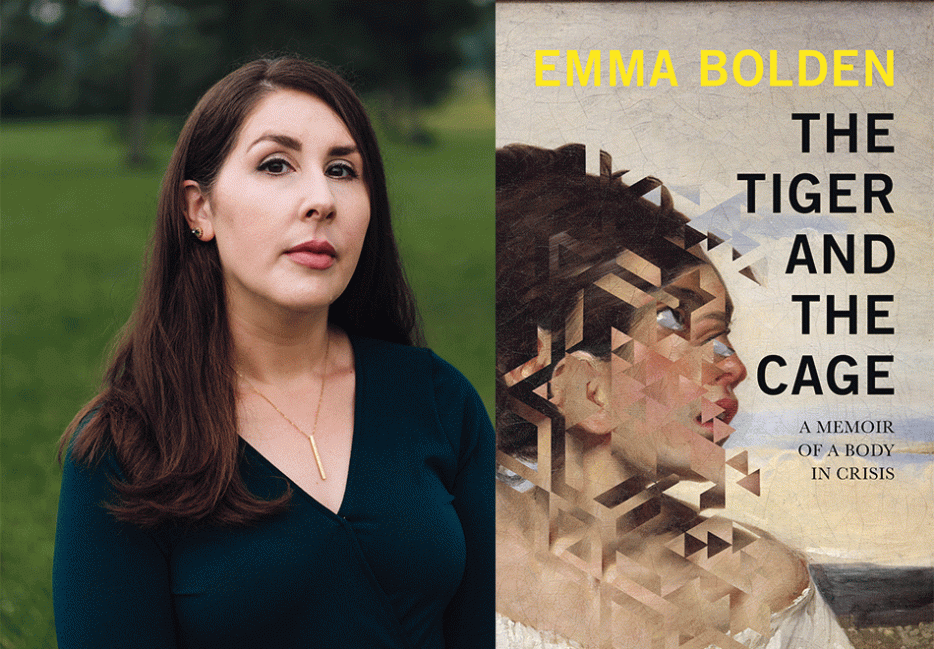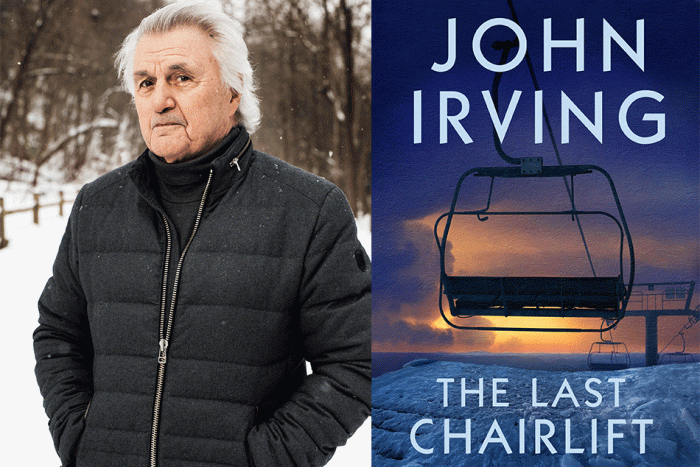“Because we’ve been taught that our stories, that the blood and fear and vomit and pain inside our stories, are unspeakable,” writes Emma Bolden, “some of us don’t speak about them at all.” The Tiger and the Cage: A Memoir of a Body in Crisis (Soft Skull Press)—her first work of prose following several poetry collections—is a resounding testament to the power of putting words to the experiences rendered opaque by society at large. Whether revisiting early experiences of dysautonomia and endometriosis, whose symptoms doctors regularly dismiss as psychosomatic, exploring a burgeoning sense of her asexuality, or recounting a radical hysterectomy that is shadowed with signs of malpractice, Bolden approaches both her memories and the power structures that shaped them with a clarity that often crackles with rage.
Bolden and I exchange emails throughout early September, our shared name pinging back and forth over the course of several weeks: “All my best, Emma,” “With great gratitude, Emma,” “Warmly, Emma.” Seeing this profusion of Emmas, I am reminded of a moment in The Tiger and the Cage in which a high school-aged Bolden repeats the name she had at the time, Emily, until its sounds break down and lose meaning. Soon afterwards, she asks a friend to rebaptize her as Emma. It is a brief instance of self-creation, but also an attempt to distance herself from an existence increasingly shaped by both illness and dread. “I was an Emma,” she writes, “and I could pretend that I had never been an Emily, passed out on the floor of the gymnasium’s bathroom.” With The Tiger and the Cage, Bolden seems to be returning to this rebirth, but it’s no longer simply a method of escape. Here, self-construction emerges as a tool for moving deeper into the generative, if painful, constraints of the body and its emotions.
Emma R. Cohen: I’m curious to begin by talking a bit about the generic and formal shifts that came with The Tiger and the Cage. This is your debut memoir, but you have grappled with similar subjects—illness, loss, the relationship between language and pain—in your previous works of poetry. What motivated this move to nonfiction? And what was it like for you to work in a new genre?
Emma Bolden: I’ve long been of the Emily Dickinson school when it comes to dealing with difficult subjects: “Tell all the truth but tell it slant.” It takes me a while to be able to handle the hard stuff—my experience of and feelings about illness, loss, and mourning; what it means to live in a body with chronic pain; what that chronic pain does to one’s life as a whole—in direct language, so I often write poetry about it first. Poetry lets me ease into my feelings, as though the subject is radioactive; poetic language the protective gloves that allow me to handle it. Poetry was the only way I could talk to myself and others about knowing I could only go so much longer without having a hysterectomy and, as a result, that my fertility had a deadline.
After my hysterectomy, everything changed. None of my old tactics or techniques worked, and, perhaps as a consequence, I had a tremendously difficult time dealing with my emotions. My mother, very wisely, told me that I had to face what had happened head-on: “You have to go through this,” she told me. “You can’t go around it.” I started to see writing differently. Instead of a construct that allowed me to approach an experience at an angle, I saw the blank page as the only place where I could speak openly about my hysterectomy—a subject that, unfortunately, still feels like a taboo. I’d written nonfiction before, but mostly in the form of lyric essays; I decided to try to write as directly and frankly as I could. And the words just poured out of me. It felt like I’d finally been freed from shame, from a secret I’d just realized I no longer had to keep. Writing in a different genre in a different way felt strange, but it also felt incredibly right—and it felt like the greatest relief, to just be able to say it.
It’s moving to hear that the writing process was an unburdening for you in some way, and I’m curious to hear more about other ways that this project might have affected your understanding of illness. In both your poetry and your prose, you discuss the ways that pain and illness can undo a stable sense of self. Early on in The Tiger and the Cage, for instance, you write, “There I am, the person I cannot remember as a person, the person detached from her being, from her body, who no longer lived inside of a story she could understand.” Do you find the linear narrative of memoir to be a way to reinsert some stability, or to access a newly legible story? I often think of memoir as a space of self-construction, but I wonder if that quality takes on greater significance here.
To be honest, structure is what I struggled with the most. I worked on this memoir for a very long time—the memoir as a whole for seven years, though there are individual pieces that used to be in essays that are over ten years old. For a year or two, I tried to shape it into the form of a traditional, linear narrative. It was an absolutely necessary step for me because I needed to try to tell the story to myself in a way that made some kind of sense: I needed to know what the facts looked like, lined up that way, almost as if I were performing a clinical examination. However, it absolutely did not work for the story I was trying to tell, mainly because the crux of the story is that it doesn’t make sense. There are too many pieces missing (sometimes literally, as the surgical records for my hysterectomy were missing several key pages) and there are too many moments in which the story folds back on itself and I find myself at the beginning again.
My agent, Cassie Mannes Murray, is also a spectacular editor and writer; she suggested that I read Jane Alison’s Meander, Spiral, Explode: Design and Pattern in Narrative—a book that changed the course of my writing life and the way I thought about structure. I realized that there was just no way to convey what happened in a traditional narrative. Instead, the book works more like a fractal: a series of patterns that repeat and repeat at different scales, accreting information and detail as the memoir moves on. I found inspiration in music rather than language: While I was revising the memoir, I listened to Maurice Ravel’s “Bolero” every day. Immersing myself in music that moved the same way helped me to understand how to structure the memoir, which in turn helped me to understand what I’d been through. My story isn’t one with a beginning, middle, and end; it’s a story of “again, and again, and again.” Seeing my experience through the lens of that structure not only helped me to understand myself, it also helped me to forgive myself: I could see how bewildering my life had been, and I could better understand and accept my frustration and impatience.
Do you find that there’s any relationship between the objectifying medical gaze and the process of turning an exacting lens on your own experience when writing?
I definitely think there’s a connection between that objectifying medical gaze and the way I had to look at myself and my experience to write this book. Before I could convey what it felt like to live this experience, I had to know the facts of the experience—which were sometimes hard to come by. After my surgical accident, for instance, my doctors gave as little information as possible, so I had to restructure that through talking to my parents and doing research. It’s difficult, too, to take a “just the facts” look at something that’s as emotionally heart-rending as a total hysterectomy, especially one with major complications afterward. I had to look at things in a wholly clinical, objective way in order to accurately describe what happened. Interestingly, this mirrors a lot of my real-life experience with doctors and with using medical language to stand up for myself. Sometimes, proving that I’m looking at something objectively and without emotion has been the only way to get a doctor to believe me.
I wanted to make sure I asked you about metaphor. The title of the book is drawn from a moment in which a nurse is attempting to help you visualize your condition by describing your nervous system as a tiger trapped in the cage of your body. And in your poetry, you have explored the tendency of doctors to refer to your body as a house. Even outside of medical contexts, it seems true that the slipperiness of embodied experience requires us to turn towards metaphor, even when those metaphors are unsatisfying, imprecise, or flattening. How do you navigate this situation in your own writing? Do the metaphors used by doctors always feel stale, or are they ever surprising, even useful?
It’s something I think about a lot in all genres, especially when it comes to the body. I’ve realized that what was so infuriating about the metaphor of the body as a house was its implication of emptiness. The metaphor implies that the female body exists solely to house a fetus, and if that doesn’t happen—if the female body is a house for the self and the self only—it is somehow empty and incomplete. As a metaphor, it’s imprecise, but it also views the female body in terms of function, implying that if a female body doesn’t fulfil that function, then it has no purpose.
I’m very interested in the fact that doctors so often use metaphors for describing the female body, especially since some of the metaphors are kind of absurd. There’s this whole citrus fruit scale for the size of fibroid tumors—you’re told it’s the size of a lemon, an orange, a grapefruit. I know someone who was told her fibroid was the size of a chicken, which seems especially absurd. On one hand, the fact that doctors so often resort to metaphors intrigues me because it shows that, in some sense, medicine and literature perform similar functions for us: they strive to find a way to explain the inexplicable facets of living in a human body, including suffering, illness, and death. On the other hand, even if the metaphors are horrible, I find them useful because, well, they work as doorways to some terrible jokes. In the memoir, I mention that an emergency room doctor described the cuff (a closure created where the cervix is removed in a total hysterectomy) as a tube sock, which turned into a long-running joke between myself and my best friend. Humour is my number one coping mechanism (besides bad television, which also appears in the memoir), so I’m grateful when a particularly absurd metaphor pops up.
That shared, or at least adjacent, function of medicine and literature is so interesting to me—literature seems so much more agile in crafting meaning that isn’t stultifying, and yet we so often turn to medicine for understanding and reassurance.
I was wondering whether there were other texts that you were in conversation with as you were working on The Tiger and the Cage, and especially whether you engaged at all with other illness narratives. I really appreciated that The Tiger and the Cage sidesteps many of the tropes that tend to populate illness narratives—battle metaphors, neatly-packaged lessons learned, straightforward progressions from diagnosis to treatment to cure—and I was curious what your relationship might be to that genre as a whole.
I do have a strange relationship to many other illness narratives, particularly those that show a straightforward progression or anything that’s neatly packaged. If there’s anything I learned from my own experience with chronic illness, it’s that it’s anything but neat and straightforward: it’s a mess, and it makes a mess of much of your life. This may have to do with the nature of the illness I’m describing: it takes six to ten years for most people to be definitively diagnosed with endometriosis. I was unofficially diagnosed at thirteen and officially diagnosed at seventeen, so, in a sense, I was lucky. There’s also no cure for endometriosis and no treatment (even a hysterectomy) was especially helpful for me, so that’s another reason why neatly packaged narratives about illness just don’t entirely work for me. I greatly admire writers who approach the subject from various angles and in shattered, lyric forms. Sarah Manguso’s The Two Kinds of Decay, for instance: it’s a series of short, linked lyric essays showing her struggle with a mysterious illness and blood treatments that seem as absolutely brutal as the disease. The book shows so vividly how illness often seems like a recurring loop: “The events that began in 1995 might keep happening to me as long as things can happen to me.” She also does an incredible job conveying how you focus on small things during moments of intense distress: there’s a scene I’ll never forget in which she’s eating French fries during a blood treatment.
Maybe a more immediately visible set of interlocutors for your text are the “hysterical” women throughout history that you engage with, such as the patients in Jean-Martin Charcot’s clinic. You’ve drawn on historical material in your poetry as well—I’d love to hear about how you first grew interested in these figures, and what it was like engaging with their archives as you developed your text.
The sections about hysteria were the earliest pieces written and the last to find their way into the book. I hadn’t really heard of hysteria until I was a freshman in college and read Elaine Showalter’s The Female Malady and Hystories. The books knocked the breath out of me, both as a person who’d had a physical issue that was the embodiment of mental turmoil (a coughing fit in fifth grade) and as a person whose doctors dismissed some very real physical issues (dysautonomia and endometriosis) as being merely “in my head.” Hysteria kept popping up in my classes: the courses I took on Rilke and Ibsen, as well as a class on “talking cures” in psychology. Another thing that kept popping up: the fact that, Showalter’s work aside, most of these women’s stories were told and controlled by patriarchal institutions.
In my drawing class my senior year of college, I did a series of drawings based on the photographs of hysterics by Albert Londe, the photographer Jean-Martin Charcot hired to capture images of the women in his clinic. I wanted to help them escape the frame of his photographs, to show them as humans, not as specimens. I’ve kept thinking of them, all of these years, especially with everything I’ve been through with doctors; when I first started writing nonfiction, I returned to their stories, trying to understand what had happened to them, what had been done to them, by writing about the experience of medical treatment from their point of view. I tried, from time to time, to write poems from the point of view of some of Freud’s patients, but they never really went anywhere. The pieces I’d written about hysteria hung around on my hard drive for about ten years, until I was working on a draft of the memoir that just felt incomplete. I returned to those decade-old pieces and realized that they offered me a way of looking at the story, at women’s history, and at medicine that could complete the fractal patterns of the book. I also realized that this part of history, in which women and bodies were expected to perform in certain ways, in which institutions denied women the care they needed as well as agency over their own bodies—that it wasn’t really history, after all.
Wouldn’t it be nice if patriarchal medical practices were relegated to the dustbin of history! Maybe this would be a good moment to talk about the role of the “good patient.” I often notice how easy it is for me to slip into this docile role, and how hard it is to unlearn the habit of growing quiet and complacent when faced with a doctor. You grapple with this dynamic repeatedly in your memoir, and I’m curious to hear more about it. Does the fact of writing, the insistence on not remaining quiet (at least after the fact), automatically trouble the expectations we have for patients? And has the practice of writing changed your experience as a patient at all?
It’s so, so easy to slip into that docile role, and I wish that I could say that, after everything, I was better about it—and braver about standing up to doctors—than I am. I am better, to a degree, but I still struggle with the dynamic. Writing about my experience gave me more strength when it comes to facing skeptical doctors, simply because I had amassed a pile of evidence that showed that I did have real medical problems, that I had every right to seek medical care, and that I also had every right to find a new doctor after being dismissed. I don’t think those words express just how radical those statements are for me—and for so, so many other women. More than anything, that’s what writing about this has shown me: that medical gaslighting and deferral or refusal of care happens to so many people.
A few weeks ago, I saw a doctor who explained that my MRI and X-rays showed a herniated disc with bone spurs compressing my sciatic nerve along with spinal arthritis—and then informed me that the real source of my pain was emotional damage, since I had a hysterectomy before I married or had children. I was in utter disbelief and cut the appointment short, though I do wish I’d stood up to him more firmly. I tweeted about the incident just to let off steam, and was shocked when the tweet went viral—and that other people, especially female-identifying patients, had responded with their own (horrifying and terrifying) stories. I feel like conversations with this kind of truth-telling—which happen far too rarely—are vitally important, and I’m hopeful that troubling the waters can give people strength. Sometimes, being a good patient means standing up for yourself and finding a practice that offers better care.
I’m not surprised that the tweet went viral—it’s infuriating and all too familiar. One of the things I appreciated about your book was its willingness to engage with angry feelings and anger-inducing critiques, without claiming that anger is the only or easiest response to unjust situations. Sometimes getting and staying angry can be challenging!
Oh my gosh, yes—it was really important for me to engage with anger in the memoir because it’s such a difficult emotion. I have a hard time with it because I’ve been so conditioned to think of anger as a negative thing and to move immediately to guilt instead, but what I’ve realized is that when properly harnessed, anger can be a constructive force that leads to positive change. You are absolutely right, getting and staying angry can definitely be challenging—and for me, a lot of the time that’s because I have to convince myself that it’s okay for me to feel angry in the first place.
If you’re up for it, I’d love to hear what direction you’re moving in next.
I’ve actually been writing a fantasy novel? The question mark is there because that is something I honestly never imagined myself doing, but the start of the story suddenly appeared and then the rest of the story kept coming. It’s an extension of the research about the European witch trials that I did for my first collection of poetry, Maleficae. Those events and ideas—as well as their frightening similarity to present day law and politics—have always been in the back of my mind, and it felt like the right time to return to them, as if I’m finally coming full circle.






